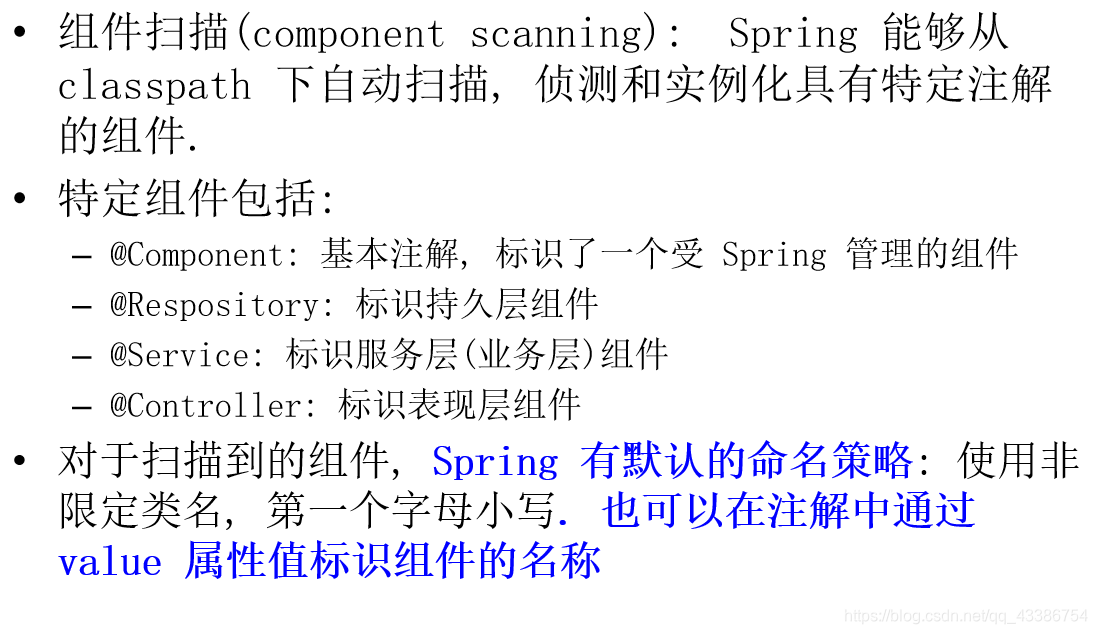版权声明:--------------------------新手上路,如有不正确的地方,还请多多指出不足之处--------------------------- https://blog.csdn.net/qq_43386754/article/details/88083561
什么是注解?
- 在jdk1.5的时候就引入了注解,最为常见的就是复写方法的时候在方法上写上"@Override",以及在使用JUNIT4做测试的时候,常常会使用到"@Test","@Before"m"@After"等等符号,这样符号就称之为注解,
- 但注解不仅仅是一个符号而已,每个注解都有一个特定的功能,例如在编写Servlet程序类的时候,使用"@WebServlet"注解就可以轻松指定该Servlet的访问路径,而不需要到web.xml文件中再进行配置.
- 实际上每个注解其实就是一个接口,java通过反射来访问相关API的信息,被注解的类,根据这些信息来进行某些特定的行为.
为什么使用注解?
- 在使用spring框架的时候,往往需要为大量的Bean配置xml文件,随着时间的推移,这些xml文件会越来越庞大,当时候会很难维护.
- 而通过注解的方式,就可以通过简单的实现对Bean的配置,使代码更加的简洁.
使用注解的缺点
- 注解也不是万能的,虽然使用注解配置Bean会更加的方便,但也会有以下几个问题
- 使用注解的方式没有直接使用xml文件的方式执行效率更快,这是因为,使用注解的时候,还需要IOC容器对指定的包进行扫描,而xml文件不需要直接通过反射全类名的方式实例化.
- 过于分布的注解,使用不当,还可能导致配置混.
Spring中使用注解配置Bean
- 以下的四个注解可以混用,这是因为Spring还无法分辨注解的Bean是属于DAO层还是服务层
- 图片转载自尚硅谷的教学ppt



示例:Spring注解使用
- 模拟一个分层程序设计,DAO层,服务层,业务层,控制层
- 定义Employe.java程序类,描述雇员表中的信息传输类
@Repository
public class Employee {
private Integer id;
private String name;
private Integer age;
private String job;
//getter和setter方法
}
- 编写 EmployeeDAO类,模拟一个持续化操作类
@Component
public class EmployeeDAO {
public boolean doCreate(Employee employee){
return true;
}
}
- 编写EmployeeService程序类,描述服务层
@Service
public class EmployeeService {
public boolean add(Employee vo){
EmployeeDAO employeeDAO = new EmployeeDAO();
return employeeDAO.doCreate(vo);
}
}
- 编写一个EmpAction程序类,描述控制层
@Controller
public class EmpAction {
private Employee vo = new Employee();
public Employee getVo() {
return vo;
}
public void setVo(Employee vo) {
this.vo = vo;
}
public String add(){
EmployeeService employeeService = new EmployeeService();
if(employeeService.add(this.vo)){
return "add_list.jsp";
}else{
return "error.page";
}
}
}
-
此时每一个注解都是用默认的名称,也就是说在IOC容器中,Bean的id都是类名称首个字母小写,例如:"“empAction”
-
配置annotation_employee.xml文件
<?xml version="1.0" encoding="UTF-8"?>
<beans xmlns="http://www.springframework.org/schema/beans"
xmlns:xsi="http://www.w3.org/2001/XMLSchema-instance"
xmlns:context="http://www.springframework.org/schema/context"
xsi:schemaLocation="http://www.springframework.org/schema/beans http://www.springframework.org/schema/beans/spring-beans.xsd http://www.springframework.org/schema/context http://www.springframework.org/schema/context/spring-context.xsd">
<!--配置制定扫描的基类包-->
<context:component-scan base-package="mao.shu.spring.annotation"></context:component-scan>
</beans>
- 测试类
package mao.shu.spring.annotation;
import org.junit.Before;
import org.junit.Test;
import org.springframework.context.ApplicationContext;
import org.springframework.context.support.ClassPathXmlApplicationContext;
import static org.junit.Assert.*;
public class EmpActionTest {
private ApplicationContext app;
@Before
public void before(){
this.app = new ClassPathXmlApplicationContext("mao/shu/spring/annotation/annotation.xml");
}
@Test
public void test(){
//获取持续化类Bean
Employee employee = this.app.getBean("employee",Employee.class);
//获取DAO操作类实例Bean
EmployeeDAO employeeDAO = this.app.getBean("employeeDAO",EmployeeDAO.class);
//获取服务层操作类Bean
EmployeeService employeeService = this.app.getBean("employeeService",EmployeeService.class);
//获取控制层Bean
EmpAction empAction = this.app.getBean("empAction",EmpAction.class);
System.out.println(employee.getClass());
System.out.println(employeeDAO.getClass());
System.out.println(employeeService.getClass());
System.out.println(empAction.getClass());
}
}
- 输出结果
